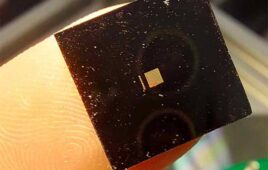
The vagus nerve originates in the brain and travels to the periphery of the body, transporting signals that may affect autoimmune and metabolic diseases.
A 2014 study showed that inflammation-causing proteins known as cytokines were present in the plasma of lupus patients up to several weeks before their disease flared up. Conversely, these Oklahoma researchers found that inflammation regulators are present during periods when the disease is stable.
Now, researchers at The Feinstein Institute for Medical Research (Manhasset, N.Y.) are working to decipher the neural signals of inflammation that other parts of the body send to the brain. In a recent study, they exposed mice to two inflammation-causing cytokines — tumor necrosis factor (TNF) and Interleukine 1β (IL-1β) — to determine whether cytokine-specific information is present in signals within the vagus nerve. The study was published in the Proceedings of the National Academy of Sciences.
“Our research is based on the idea that our body has mechanisms in place that sense these and inform our brain of the inflammation. Once alerted, our brain sends a signal to the spleen to trigger an immune response,” said principal researcher and Assistant Professor Theodoros Zanos in an interview with Medical Design & Outsourcing. “The problem with a lot of autoimmune diseases is that the immune response is exaggerated, possibly due to the fact that this back-and-forth between the brain and the spleen does not work.”
The authors are developing algorithms to help decipher and communicate immune states, according to Zanos, who also spoke recently at DeviceTalks Boston.
“You’re looking to decipher the language of the nervous system. To do this, you use math and computer algorithms that find patterns in data and interpret them in a specific way. Our use of machine learning is based on exactly the same premise,” he said. “You take neural data, you find patterns in it and then you tie it to a specific goal, whatever you’re looking to decode, whether that’s movement, a stimulus or a disease state. This is essentially what we call neural decoding. That’s the effort to translate these signals.”
The Oklahoma researchers tested patients’ plasma for the signals that indicated a flare-up. The Feinstein researchers want to show whether identifying and tracking inflammation markers in neural signals rather than plasma can help both the people diagnosed with autoimmune diseases and their physicians to monitor their conditions. Ultimately, Zanos and his colleagues aim to develop bioelectronic closed-loop systems that would read and respond to the signals that traverse the body, not only for immune diseases but for metabolic ones as well, including diabetes.
“What we’re proposing is, instead of constantly taking blood samples from patients, why don’t we just use the sensors that we already have in our body?” Zanos said. “They are already recording and sending this information to the brain. Let’s listen to it and decipher it. Obviously, it’s not that simple and it’s not easy, but it’s worth trying.”
The Feinstein researchers will continue studying the signals detected in their preclinical work in hopes of translating the results to larger animals and one day, to humans. If their hypothesis proves correct, Zanos believes that a device for use in humans could be deployed in a decade.
“We know that our body has all these reflexes to maintain homeostasis. It only makes sense that these internal sensors continuously monitor and report our current state. We would take advantage of this existing information and develop appropriate algorithms to translate it. We should be able to do this,” Zanos said.
“Again, that’s a leap between our current capabilities and what we envision to accomplish, but I think we’ve shown that, at least as a proof of principle, this is an attainable goal,” he added. “As soon as we show that this has promise and this is actually feasible in humans, we anticipate growing interest and support from the research community and the industry.”




